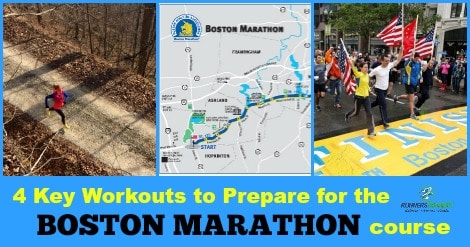The journey from Hopkinton to Copley is one of the most famous treks in marathon racing. Many a runner has spent a career chasing their Boston qualifying time and, thanks to Boston, moving up an age bracket is perhaps the only reason a runner actually celebrates a birthday.
While some runners prefer to run the Boston marathon at an easy pace, taking in the sites and enjoying their well-earned reward for qualifying, many runners relish in the opportunity to race against history and challenge the infamous course.
If your goal is to conquer the Boston course, then it is critical that you’re aware, and practice for, some of the quirks that make Boston so special.
In this article, we’ll look at three important and unique factors to racing Boston and outline the steps you can take in the next three weeks to bolster your chances of having a great race on Marathon Monday.

1. Adjusting to the mid-morning start time
Perhaps the most interesting twist at the Boston Marathon is the late start time.
Almost all other major marathons begin early in the morning before most “normal” people are out of bed; however, the Boston Marathon starts at 10am or later, depending on your corral seeding.
While this late start time is great for spectators, it can create confusion when you’re accustomed to racing and training early in the morning, especially when it involves what to eat before the race.
With just a few weeks to go before your race, now is the time you need to start honing in on your pre-race meal and teaching your body how to run mid-morning.
While it may only take one or two hard workouts to adjust to running at 11am, figuring out what to eat might require a bit more experimentation.
My suggestion for eating is to wake-up moderately early, say six or seven, and consume a substantial breakfast that will sit well in your stomach and provide the fuel you need.
This will ensure that you have ample time to digest what you eat and let the food settle.
I recommend foods such as oatmeal, a bagel with peanut butter, energy bas, yogurt with granola, a banana or some V8 juice. From here, you can go back to bed or simply relax until run time. Depending on your start time, you can than consume a much smaller meal, with more simple sugars an hour before your gun time.
Since this approach is so far from what your might normally do, you should simulate this strategy on your last few weekend workouts or long runs.
You don’t want to realize a week before the race you don’t know what sits in your stomach well, especially since you can’t survive on normal pre-race foods like GU if you have a sensitive stomach.
Further, as anyone who’s run track and therefore competed in lots of afternoon and evening races, not racing first thing in the morning can be more jarring than it appears and you need to prepare your body for this.
2. Practice pacing
I’ve written many times before on this blog about the importance of pacing and provided some helpful tips for how to hone your sense of pace.
Perhaps nowhere is pacing more important than the fabled Boston course
As such, it’s critical you spend these last few weeks perfecting your ability to run under control, especially downhill.
Almost everyone who is preparing for Boston has heard about the danger of starting too fast. But, despite the universality of this knowledge, you’ll still find many runners starting way over their heads after 5 or 10k, only to crash and burn after Heartbreak Hill.
Asked why they didn’t run slower at the start and most will say “it didn’t feel that fast”.
Over your final few marathon paced workouts, pick a course that starts slightly downhill or find one that is deceptively easy to start. The more you can simulate having to put on the brakes to run what feels like a pace that is “too easy”, the better prepared you’ll be on race day when the first few miles feel like a jog.
Don’t worry about losing any fitness. In the final weeks of training you’re not trying to gain any fitness anyway – the goal should be on starting to feel good and absorb all your hard work. It’s far more important to learn how easy marathon pace will feel the early miles and teach yourself to hold back.
RunnersConnect Bonus
Racing Boston marathon this year? Download your FREE Boston Marathon Pace Calculator now.
The Boston Marathon pace calculator uses the steepness of the hill, along with its length, to assign a difficulty score for each mile. Each mile is then extracted to provide you with the perfect pace per mile to maintain an even effort throughout the entire race.
The calculator will keep you from going out over your head over the first few miles and fading on the Newton Hills.
3. Train for the weather
A common expression in New England is “if you don’t like the weather, wait an hour”. It’s not uncommon to experience swings of 50 to 60 degrees in a matter of days in Boston, especially in the Spring.
Unfortunately, for most runners who train in freezing winter conditions, Boston has the tendency to be very warm on Patriots day.
For runners coming from warmer climates, it’s far easier to adapt to the cold than the heat. The body will instinctively perform well in temperatures down to 40 degrees for most runners. Plus, all you need to do is where extra clothes to stay warm if needed.
On the other hand, if you’ve been training in cold weather, perhaps mother nature will be on your side this year and race temperatures will remain cool. However, if a heat wave engulfs the city as it has in the past, your performance is going to suffer more than runners from warm climates.
Use these final three weeks to get heat adapted. Research has shown that it takes about five to 10 days to begin adapting to running in the heat.
- Wear an extra layer of clothes and keep the gloves and hat on, even when the weather gets above 40 and 50 degrees. You don’t have to go crazy, but consider always wearing pants and a long sleeve shirt when training these last few weeks.
- While wearing a few extra layers won’t make you as comfortable running in the heat as you would be in the middle of the summer, it will be enough to improve performance should the weather be warmer than you’ve been training in.
Race day is almost here and it’s about time to see all those long, cold, early morning miles pay off. Use these last few weeks to specifically prepare yourself for all the quirks of the Boston course and Marathon Monday and enjoy your best race yet!
[ls_content_block id=”34485″]







